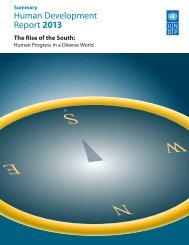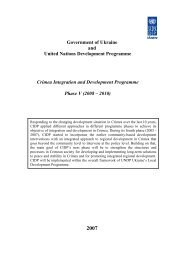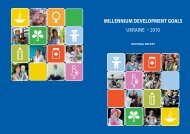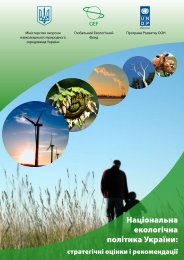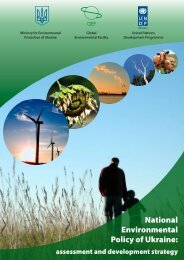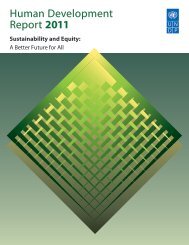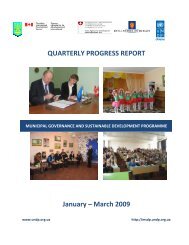E N S W - United Nations Development Programme
E N S W - United Nations Development Programme
E N S W - United Nations Development Programme
You also want an ePaper? Increase the reach of your titles
YUMPU automatically turns print PDFs into web optimized ePapers that Google loves.
progress will require coordinated policy<br />
measures across development fronts. One of<br />
the most important of these is equity, because<br />
more- equitable societies fare better in most<br />
aspects of well-being and are more sustainable.<br />
Another is reducing child mortality: rapid<br />
progress is possible in all countries through<br />
education, particularly of women.<br />
Policies also need to consider other forces<br />
that will influence development, especially people’s<br />
meaningful participation in the processes<br />
that shape their lives. Demand for participation<br />
grows as people become more educated and<br />
more connected. Other major issues are environmental<br />
and demographic change; countries<br />
need to act during brief windows of opportunity<br />
to avoid high costs in forgone human<br />
development.<br />
Most of the opportunities for sustaining and<br />
even accelerating the momentum in human<br />
development lie in the hands of national governments.<br />
In an increasingly globalized world,<br />
however, governments do not act alone. The<br />
final chapter considers the complex web of international<br />
arrangements with which national<br />
governments need to engage and how regional<br />
and global institutions can work more effectively<br />
for sustainable human development.<br />
Figure 4.9<br />
Advances in GDP per capita through 2050 are especially strong under the accelerated<br />
progress scenario<br />
GDP per capita (2000 PPP $ thousands)<br />
60<br />
50<br />
40<br />
30<br />
20<br />
10<br />
0<br />
2010<br />
2015<br />
2020<br />
2025<br />
2030<br />
2035<br />
2040<br />
2045<br />
Note: See Technical appendix for a definition of the base case and accelerated progress scenarios.<br />
Source: HDRO calculations based on Pardee Center for International Futures (2013).<br />
2050<br />
Accelerated<br />
progress scenario:<br />
very high HDI countries<br />
Base case scenario:<br />
very high HDI countries<br />
Accelerated<br />
progress scenario:<br />
low, medium and<br />
high HDI countries<br />
Base case scenario:<br />
low, medium and<br />
high HDI countries<br />
Table 4.5<br />
Number of people in extreme poverty by region and selected countries, base case and accelerated<br />
progress scenarios, 2010–2050 (millions)<br />
Region or country 2010 2020 2030 2040<br />
2050,<br />
base case<br />
2050,<br />
accelerated<br />
progress<br />
Arab States 25 19 17 16 17 1<br />
East Asia and the Pacific 211 74 42 29 29 9<br />
China 94 13 5 1 1 0<br />
Europe and Central Asia 14 2 3 3 4 1<br />
Latin America and the Caribbean 34 29 26 27 32 13<br />
South Asia 557 382 243 135 81 13<br />
India 416 270 134 53 21 2<br />
Sub-Saharan Africa 371 333 297 275 267 60<br />
World 1,212 841 627 485 430 96<br />
Note: Extreme poverty is defined as $1.25 a day in purchasing power parity terms. See Technical appendix for a discussion of the base case and fast track<br />
scenarios.<br />
Source: HDRO calculations based on Pardee Center for International Futures (2013).<br />
Chapter 4 Sustaining momentum | 103



